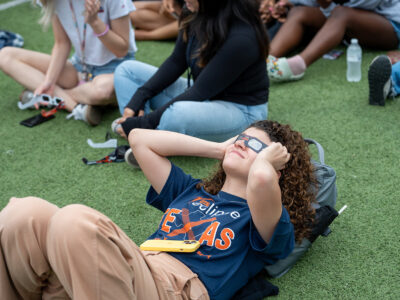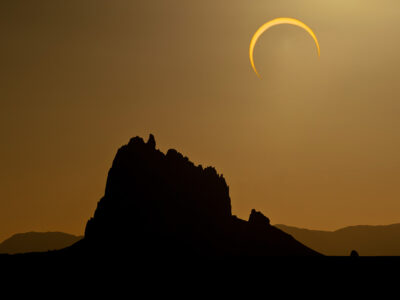San Antonio was last cloaked in the moon’s shadow during a total solar eclipse in 1397. But on Monday, April 8, the Alamo City will finally get to bear witness to this historic phenomenon once again, as the moon slowly positions itself between the Earth and the sun, leaving northwest San Antonio in daytime darkness.
It’s a once-in-a-lifetime celestial event that everyone must witness, according to Angela Speck, professor and chair of the UTSA Department of Physics and Astronomy.
“It’s hard to convey just how amazing it is to experience an eclipse,” Speck says. “It’s gorgeous to look at, but you also feel it on your skin because it cools down and you get a breeze. For me, it’s not just one thing. You have all this stuff going on all at once, and you have a very limited time to take everything in. There are also sounds of wildlife depending on where you are.”
Location is everything when it comes to fully experiencing a total solar eclipse. The path of totality, where the moon’s shadow completely blocks the sun, is a narrow strip of land about 100 miles wide. While several major cities sit in this coveted geography, including San Antonio and Boerne, only a small portion of the Earth’s surface will truly witness the historic moment. Learn more about the 2024 total solar eclipse and other future eclipses at the Great American Eclipse website.
This video from GreatAmericanEclipse.com shows the path of totality as it passes over North America (including northwest San Antonio) on April 8.
“Downtown San Antonio will not see total darkness,” Speck explained. “You’re either in the path of totality, 100%, or you’re not. At 99%, there will be so much sunlight flooding through, it’ll be like an overcast day. It’s an entirely different experience to be in the path of totality. You have to get as close to the center as you can.”
The UTSA Main Campus will be on the inner edge of the path of totality. Those on campus will catch the totality of the eclipse for 2½ minutes, from 1:33 p.m. to 1:35 p.m. Boerne viewers will get over three minutes, compared to the mere 21 seconds that viewers near Nelson W. Wolff Stadium will witness.
The entirety of the eclipse begins at 12:14 p.m. At first contact, the moon meets the edge of the sun. As the moon slowly glides over the sun, Speck urges viewers not to stare without proper protection. Eclipse glasses are critical to ensure viewers witness the progression of the eclipse.
Another method to witness the eclipse safely, and favored by Speck, is using a disco ball. Each square metallic pattern captures the shape of light from the sun, reflecting crescent patterns on the ground.
During an eclipse, temperatures drop. Birds flock throughout the darkening sky as they settle into silence and get ready to sleep. In the last moments before totality, the moon blocks enough of the sun’s rays to reveal the faint solar corona.
Unlike daily sunsets that bestow a colorful sky reserved to one portion of the horizon, a mosaic of colors will engulf the whole horizon in the seconds leading up to totality.
“There’s a huge difference just before and once in totality,” Speck says. “Look quickly or else you’ll miss it.”
Once the moon has completely covered the sun, reaching totality at 1:33 p.m. to 1:35 p.m., it’s safe to view without eclipse glasses.
“It’ll be as bright as a full moon,” Speck says.
UTSA astrophysicist Chris Packham joined the Planet UTSA podcast to discuss the educational opportunities the eclipse will bring.
The entire progression of the eclipse will end in San Antonio at 2:55 p.m.
April’s event is the last chance to catch a total solar eclipse from the contiguous United States until 2044. A total solar eclipse will sweep across western Alaska in 2033.
Learn more about the 2024 total solar eclipse and other future eclipses at the Great American Eclipse website.


